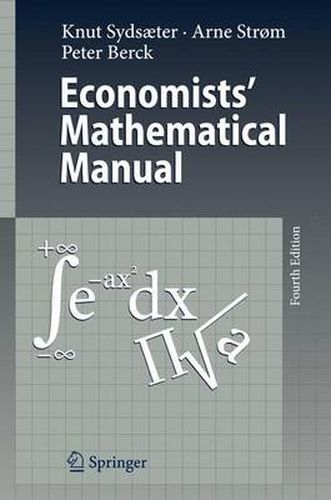Readings Newsletter
Become a Readings Member to make your shopping experience even easier.
Sign in or sign up for free!
You’re not far away from qualifying for FREE standard shipping within Australia
You’ve qualified for FREE standard shipping within Australia
The cart is loading…






This title is printed to order. This book may have been self-published. If so, we cannot guarantee the quality of the content. In the main most books will have gone through the editing process however some may not. We therefore suggest that you be aware of this before ordering this book. If in doubt check either the author or publisher’s details as we are unable to accept any returns unless they are faulty. Please contact us if you have any questions.
The fourth edition is augmented by more than 70 new formulas. In particular, we have included some key concepts and results from trade theory, games of incomplete information and combinatorics. In addition there are scattered additions of new formulas in many chapters. Again we are indebted to a number of people who has suggested corrections, - provements and new formulas. In particular, we would like to thank Jens-Henrik Madsen, Larry Karp, Harald Goldstein, and Geir Asheim. In a reference book, errors are particularly destructive. We hope that readers who ?nd our remaining errors will call them to our attention so that we may purge them from future editions. Oslo and Berkeley, May 2005 Knut Sydsaeter, Arne Strom, Peter Berck From the preface to the third edition Thepracticeofeconomicsrequiresawide-rangingknowledgeofformulasfrommat- matics, statistics, andmathematicaleconomics. Withthisvolumewehopetopresent a formulary tailored to the needs of students and working professionals in economics. In addition to a selection of mathematical and statistical formulas often used by economists, this volume contains many purely economic results and theorems. It containsjusttheformulasandtheminimumcommentaryneededtorelearnthema- ematics involved. We have endeavored to state theorems at the level of generality economists might ?nd useful. In contrast to the economic maxim, everything is twice more continuously di?erentiable than it needs to be , we have usually listed theregularityconditionsfortheoremstobetrue.Wehopethatwehaveachieveda level of explication that is accurate and useful without being pedantic.
$9.00 standard shipping within Australia
FREE standard shipping within Australia for orders over $100.00
Express & International shipping calculated at checkout
This title is printed to order. This book may have been self-published. If so, we cannot guarantee the quality of the content. In the main most books will have gone through the editing process however some may not. We therefore suggest that you be aware of this before ordering this book. If in doubt check either the author or publisher’s details as we are unable to accept any returns unless they are faulty. Please contact us if you have any questions.
The fourth edition is augmented by more than 70 new formulas. In particular, we have included some key concepts and results from trade theory, games of incomplete information and combinatorics. In addition there are scattered additions of new formulas in many chapters. Again we are indebted to a number of people who has suggested corrections, - provements and new formulas. In particular, we would like to thank Jens-Henrik Madsen, Larry Karp, Harald Goldstein, and Geir Asheim. In a reference book, errors are particularly destructive. We hope that readers who ?nd our remaining errors will call them to our attention so that we may purge them from future editions. Oslo and Berkeley, May 2005 Knut Sydsaeter, Arne Strom, Peter Berck From the preface to the third edition Thepracticeofeconomicsrequiresawide-rangingknowledgeofformulasfrommat- matics, statistics, andmathematicaleconomics. Withthisvolumewehopetopresent a formulary tailored to the needs of students and working professionals in economics. In addition to a selection of mathematical and statistical formulas often used by economists, this volume contains many purely economic results and theorems. It containsjusttheformulasandtheminimumcommentaryneededtorelearnthema- ematics involved. We have endeavored to state theorems at the level of generality economists might ?nd useful. In contrast to the economic maxim, everything is twice more continuously di?erentiable than it needs to be , we have usually listed theregularityconditionsfortheoremstobetrue.Wehopethatwehaveachieveda level of explication that is accurate and useful without being pedantic.